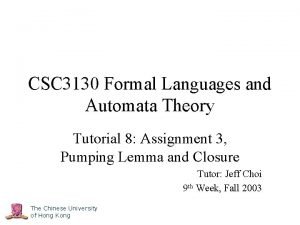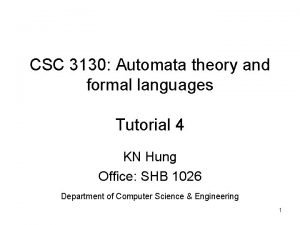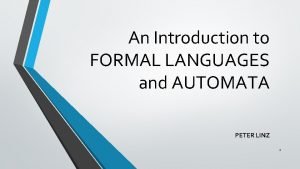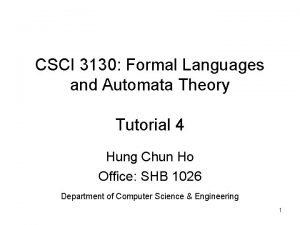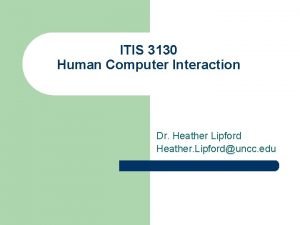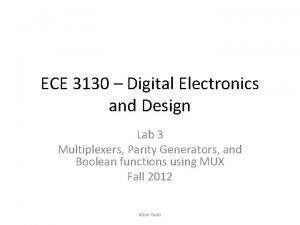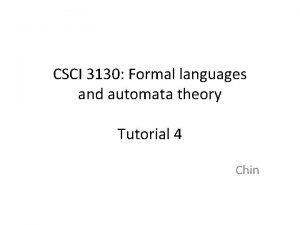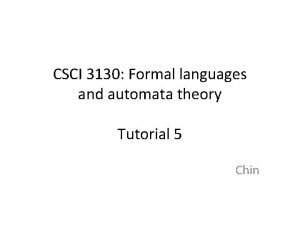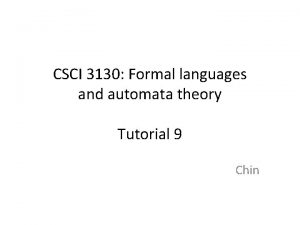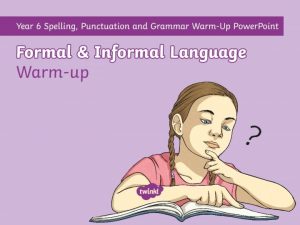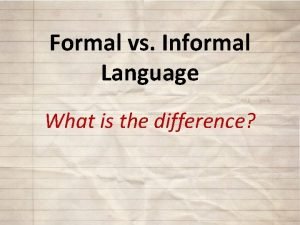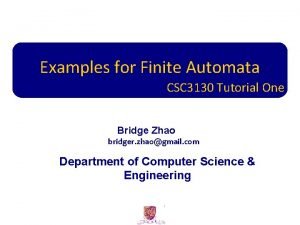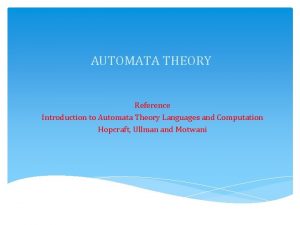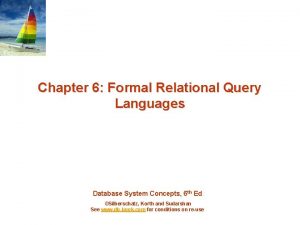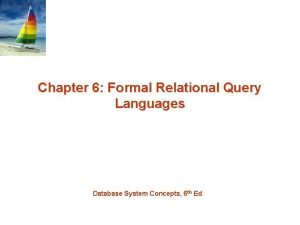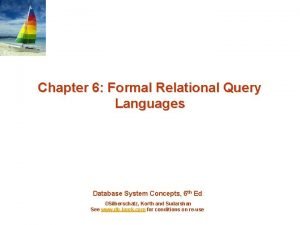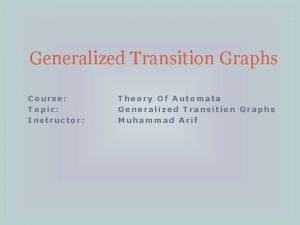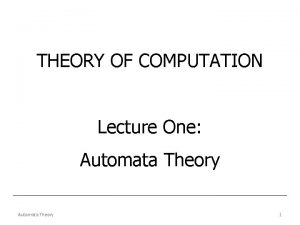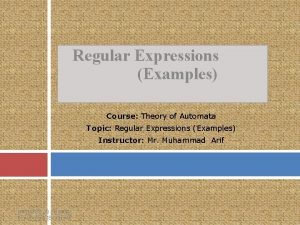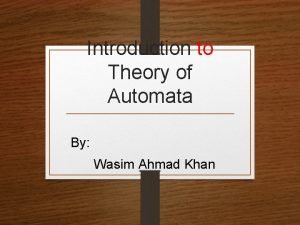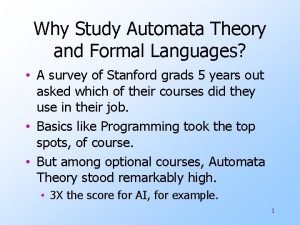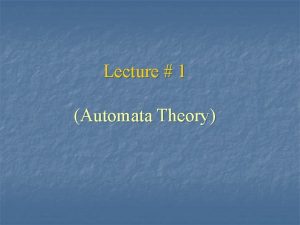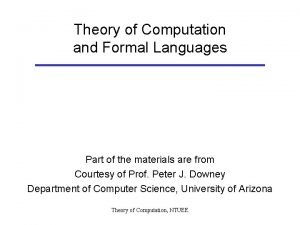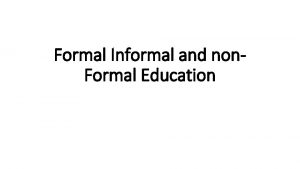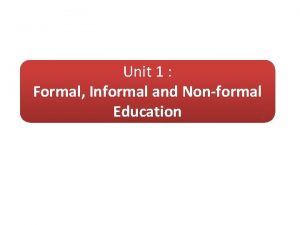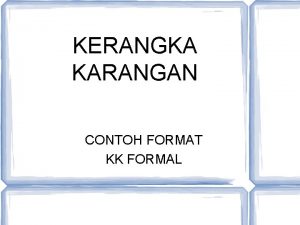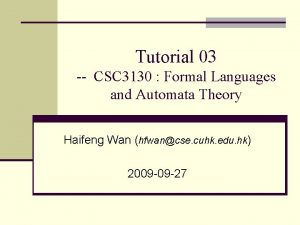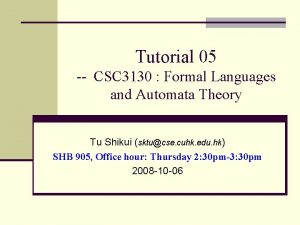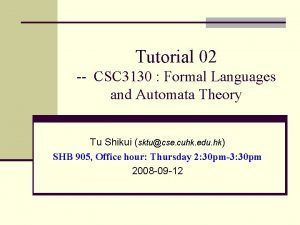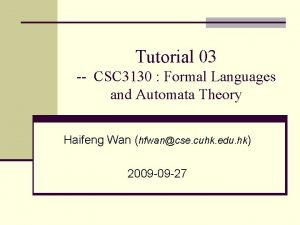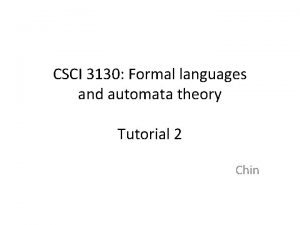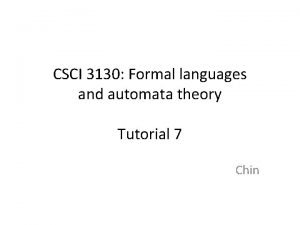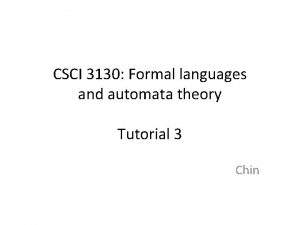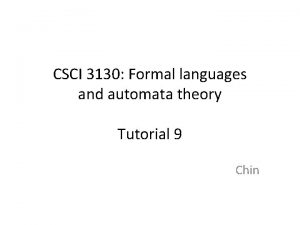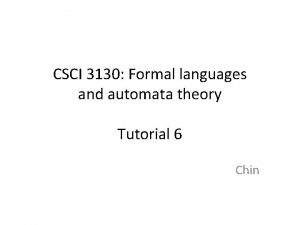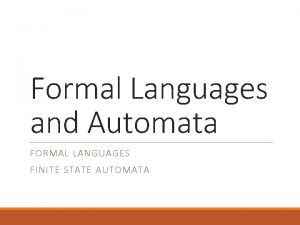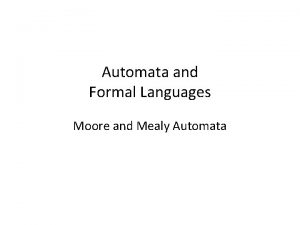CSC 3130 Formal Languages and Automata Theory Tutorial








































- Slides: 40

CSC 3130 Formal Languages and Automata Theory Tutorial 9 Undecidable Problem KN Hung SHB 1026 1

Agenda • Recap – Decidibility, Undecidibility, Turing. Recognizable … • Reduction • Undecidable Problem 2

Recap 3

Recap: Recognize • Given a language L and a machine M “M recognizes L” iff “For any w ∈ L, M halts and goes to an accepting state” • “M is a recognizer for L” • However, for w ∉ L, M may – Reject – Loop forever 4

Recap: Decide • Given a language L and a machine M “M decides L” iff “For any w ∈ L, M halts and accepts AND Otherwise, M rejects” • “M is a decider for L” • Meaning: M can determine whether a given string is in L or not 5

Recognize VS Decide • • Recognize = Halts for accepting input Decide = Halts for all inputs Decide => Recognize Make sure that you can distinguish these two concepts! 6

Recap: ~able / ~ability • L is Turing-recognizable iff there is a TM that recognizes L • L is decidable iff there is a TM that decides L • L is undecidable iff there is no TM that decides L 7

Recognizability VS Decidibility Turing. Recognizable Decidable For a language, L, located here, there is no machine that halts 8 for all input string

Some Decidable Problems • The following problems are decidable – ADFA = {<A, w> | A is a DFA that accepts w} – ANFA = {<A, w> | A is a NFA that accepts w} – EDFA = {<A, w> | A is a DFA and L(A) = Ø} – EQDFA = {<A, B> | A, B are DFAs, L(A) = L(B)} – ACFG = {<G, w> | G is a CFG that generates w} 9

Some Undecidable Problems • The following problems are undecidable – ATM = {<M, w> | M is a TM that accepts w} • To prove undecidability of a problem using reduction, ATM is used very frequently (nearly in all situations) • Used in Example 1 and 2 (Later slides) 10

Reduction 11

Reduction • • Occurs in daily life… Problem A: Travel to Japan Problem B: Buying a air ticket to Japan Problem A reduces to Problem B – Meaning: Settling B automatically solves A – Put in logical statement: B is solvable A is solvable 12

Reduction Buy an air ticket Reduce to Travel to Japan The problem “To buy an air ticket” encloses The problem “To travel to Japan” 13

Reduction B Reduce to A Problem B “encloses” A So, B is solved => A is solved Thus, B is no harder than A! 14

Reduction • A reduces to B • A is reducible to B B A Reduced to – If B is solved, then A is solved – i. e. , Whenever there is a solution to B, then there is a solution to A • If A cannot be solved, then B cannot be solved (Contrapositive) • Thus, B is no harder than A 15

Undecidable Problems 16

Example 1 • Show that REGULARTM is undecidable • REGULARTM = {<M> | M is a TM and L(M) is a regular language} 17

REGULARTM is undecidable? • Idea (By Contradiction): – Assume there is a TM R that decides REGULARTM – Construct a TM S that decides ATM – Contradiction! 18

Construction of S • On input <M, w> – where M is a TM and w is a string: • Construct M’ by M and w • Run R on <M’> • Output the answer 19

Idea of M’ • Strategy: Convert M into another TM M’: M’ recognizes a regular language iff M accepts w • If M accepts w, let M’ recognizes {0, 1}* • Otherwise, let M’ recognizes {0 n 1 n} • With the above properties – When we run R on <M’>, the output is “accept” iff M accepts w – Why…? [See next few slides…] 20

Construction of M’ • M’ = “On input x: 1. If x has the form 0 n 1 n, accept 2. If x does not have this form, run M on input w and output answer” • {0 n 1 n} is recognized by M’ anyway • How about the other strings? 21

Construction of M’ • For strings of form 0 n 1 n, M’ accepts • For all the other strings, listing all cases… – If M accepts w • they are all accepted by M’ – If M rejects w • they are all rejected by M’ – If M loops on w M’ = “On input x: • they all loop on M’ 1. If x has the form 0 n 1 n, accept 2. If x does not have this form, run M on input w and output answer” 22

L(M’) in relation to S • If M accepts w – M’ recognizes {0 n 1 n}∪{0, 1}* – {0, 1}* is regular – R will accept M’ • If M does not accept w – M’ recognizes {0 n 1 n}∪Ø – {0 n 1 n} is not regular – R will reject M’ 23

REGULARTM is undecidable • • Assume “R that decides REGULARTM” exists We construct S to decide ATM “On input <M, w>, where M is a TM and w is a string: 1. Construct the following TM M’ M’ = “On input x: 1. If x has the form 0 n 1 n, accept 2. If x does not have this form, run M on input w and accept if M accepts w” 2. Run R on input <M’> 3. Output the output of R” • Now, S decides ATM… Contradiction! 24

Example 2 • L = {<M, w> | M accepts all strings shorter than w} • Show that L is undecidable 25

L is undecidable? • L = {<M, w> | M accepts all strings shorter than w} • Again, we try to use the undecidability of ATM to achieve a contradiction • Idea (By Contradiction): – Assume there is a TM R that decides L – Construct a TM (by R), S that decides ATM – Contradiction! 26

Construction of S • On input <M, w> – where M is a TM and w is a string: • Construct M’ by M and w • Run R on <M’, ? > – This time, we have a TM that takes 2 arguments – a TM, and a string – as inputs – Think what string to put as the 2 nd input • Output the answer 27

Idea of M’ • Strategy: Convert M into another TM M’: M’ accepts all strings shorter than z iff M accepts w • We want to achieve the following: – When we run R on <M’, z>, the output is “accept” iff M accepts w 28

Idea of M’ • Strategy: Convert M into another TM M’: M’ accepts all strings shorter than “ 1” iff M accepts w • We want to achieve the following: – When we run R on <M’, “ 1”>, the output is “accept” iff M accepts w 29

Construction of M’ • M’ = “On input x: 1. If x =ε Run M on w Output the answer 2. If x ≠ε Reject 30

Construction of M’ • For M’ – If M accepts w • the only possibility is input isε AND M’ accepts ε – If M rejects w, • Case 1: x =ε – M’ rejects • Case 2: x ≠ε – M’ rejects – If M loops on w • Case 1: x =ε – M’ loops • Case 2: x ≠ε – M’ rejects M’ = “On input x: If x =ε run M on w and output answer If x ≠ε reject” 31

Construction of M’ • For M’ – If M accepts w • M’ accepts only ε – Otherwise • M’ does not accepts any string – including ε M’ = “On input x: If x =ε run M on w and output answer If x ≠ε reject” 32

L(M’) in relation to S • If M accepts w – L(M’) = {ε} – {ε} is exactly the language that contains all string shorter than “ 1” – S accepts <M’, “ 1”> • Otherwise (i. e. , M loops on or rejects w) – L(M’) = Ø – S rejects <M’, “ 1”> 33

L is undecidable • Assume “R that decides REGULARTM” exists • We construct S to decide ATM “On input <M, w>, where M is a TM and w is a string: 1. Construct the following TM M’ M’ = “On input x: 1. If x =ε Run M on x Output the answer 2. If x ≠ε Reject 2. Run R on input <M’, “ 1”> 3. Output the output of R” • Now, S decides ATM… Contradiction! 34

Conclusion 35

Pf: Undecidability by Reduction • Given an undecidable language, L • Assume such a decider TM R, exists R 36

Pf: Undecidability by Reduction • Given an undecidable language, L • Assume such a decider TM R, exists • Construct a TM, M’, by M and w – M is from input M Modify R Input M’ w 37

Pf: Undecidability by Reduction • Given an undecidable language, L • Assume such a decider TM R, exists • Construct a TM, M’, by M and w – M is from input • Feed M’ to R M Modify R Input M’ w 38

Pf: Undecidability by Reduction “M acc w” then ACC • Given an undecidable language, L • Assume such a decider TM R, exists • Construct a TM, M’, by M and w – M is from input • Feed M’ to R • If you are right M Modify Otherwise, REJ R Input M’ w – R will accept M’ iff M accepts w – R will reject M’ iff M does not accept w • Thus, you obtain a decider for ATM – Contradiction!! 39

Q&A • Thanks for coming! • I understand that this topic is confusing… • Should have some questions? 40
 Csci 3130
Csci 3130 Formal languages and automata theory tutorial
Formal languages and automata theory tutorial Formal languages and automata theory tutorial
Formal languages and automata theory tutorial Formal languages and automata theory tutorial
Formal languages and automata theory tutorial Csci3130
Csci3130 Gtg stands for in automata
Gtg stands for in automata Csci3130
Csci3130 Heather lipford
Heather lipford Ece 3130
Ece 3130 Ece 3130
Ece 3130 Ece 3130
Ece 3130 Csci 3130
Csci 3130 Cisc 3130
Cisc 3130 Pushdown automata
Pushdown automata Csci 3130
Csci 3130 Informal language definition
Informal language definition Characteristics of formal language
Characteristics of formal language Automata
Automata The central concepts of automata theory
The central concepts of automata theory Formal relational query languages
Formal relational query languages Formal relational query languages
Formal relational query languages Formal relational query languages
Formal relational query languages Gtg in theory of automata
Gtg in theory of automata Bidirectional transducers in automata theory
Bidirectional transducers in automata theory Automata theory
Automata theory Automata theory
Automata theory Is regular expression a language
Is regular expression a language Valid and invalid alphabets in automata
Valid and invalid alphabets in automata Aaaaaabb
Aaaaaabb Automata theory stanford
Automata theory stanford Reverse of a string in automata theory
Reverse of a string in automata theory Theory of computation
Theory of computation Similarities of formal and non formal education
Similarities of formal and non formal education Unit 1 formal informal and non formal education
Unit 1 formal informal and non formal education Is als a non formal education
Is als a non formal education Lenguaje formal e informal
Lenguaje formal e informal Kurikulum tidak formal
Kurikulum tidak formal Contoh kerangka karangan dalam bentuk grafik
Contoh kerangka karangan dalam bentuk grafik Komunikasi atas ke bawah
Komunikasi atas ke bawah Falasi formal
Falasi formal Keperluan esteem
Keperluan esteem

